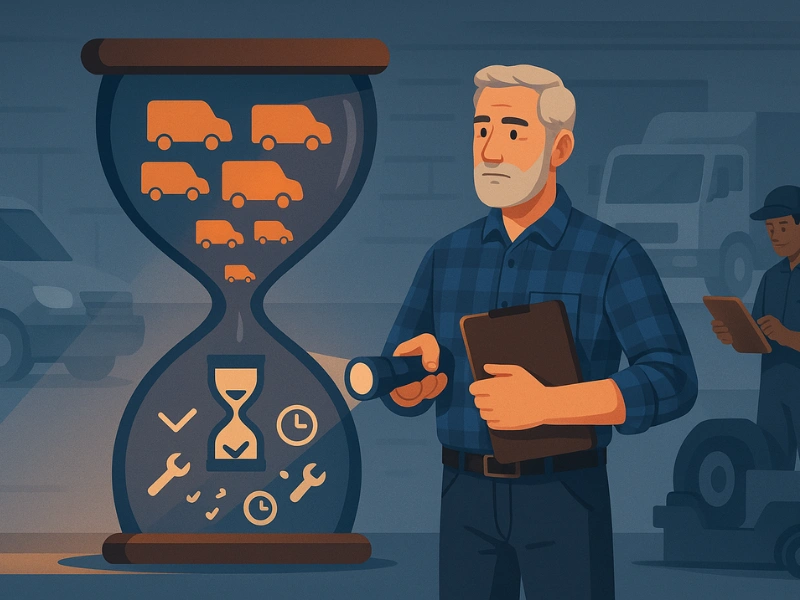Key Takeaways
- Drivers avoid apps with tiny buttons, deep menus, or slow load times.
- Overcomplicated tools lead to missed inspections, compliance risks, and inflated repair costs.
- Test any app with a 5‑minute ride‑along: Can a non‑tech‑savvy user complete a full pre‑trip inspection unaided?
- Simply Fleet offers a mobile‑first, intuitive flow, no training manuals required.
Struggling to get your drivers on board with your fleet management software? You’re not alone. Many fleet managers face the frustration of tools that promise efficiency but deliver confusion, driving teams back to outdated methods like paper checklists. This blog dives into the telltale signs your software is overwhelming your drivers and offers practical steps to test and improve its usability, ensuring your fleet runs smoothly without the tech headache.
What are the signs that fleet management software is too complicated for drivers?
If your drivers regularly skip digital inspections, ignore in‑app alerts, or revert to paper checklists, your software may be overbuilt for frontline use. Overloading users with excessive steps often causes non‑compliance and costly breakdowns.
When Software Becomes a Roadblock Instead of a Solution
What Drivers Are Saying
While many fleet management tools are rated highly for usability, driver feedback reveals persistent challenges. User reviews on Capterra highlight issues with confusing menus and lengthy workflows, suggesting that even well-regarded software can complicate daily tasks.
Similarly, on G2, where a majority of users recommend their fleet management solutions, common complaints include small tap targets and slow mobile load times, which can hinder on-the-go efficiency. These minor UX hurdles, such as tiny buttons or multi-step forms, often push drivers to revert to paper checklists, undermining the benefits of digital tools.
How Complexity Slows Down Operations

Missed digital checklists often signal driver frustration. When inspections aren’t completed accurately, maintenance alerts get ignored, and defects slip through unnoticed.
Drivers describe how:
- They abandon multi‑page forms mid‑inspection when the app times out.
- Slow‑loading menus cause delays, leading drivers to postpone inspections and often forget.
- Excessive scrolling to find the right field results in rushed or skipped entries.
The ripple effects:
- Compliance Risks: Incomplete or inaccurate logs can trigger audits, leading to fines or regulatory scrutiny.
- Escalating Repair Costs: Minor defects, like a small fluid leak, become major repairs when unreported, delaying maintenance can increase repair bills by up to 40%.
- Operational Downtime: A single skipped inspection can ground a vehicle for days if hidden faults go undetected.
- Driver Morale Drop: Frustrated drivers who waste time on clumsy workflows feel unsupported, harming retention, 68% said they’d rather stick to paper than use an app that slows them down.
By smoothing out these UX pain points, fleets can close the feedback loop, catch defects early, and keep vehicles and drivers moving efficiently.
5 Signs Your Team Is Struggling with the Current Tool
1. Incomplete Inspections
If inspection forms show default “OK” entries or blank fields, drivers are rushing or abandoning the task.
This often happens when the interface feels too cumbersome, pushing drivers to skip details in frustration.
A simpler layout could encourage them to take the time to fill out forms thoroughly.
2. Missed Maintenance Alerts
Overwhelming pop‑ups or vague notifications desensitize drivers, causing critical reminders to be ignored.
Constant alerts can blur important messages, making it hard for drivers to prioritize what matters.
Streamlined notifications might help them stay on top of essential maintenance tasks.
3. Low Mobile Engagement Rates
If fewer than 50% of drivers open the app daily, the tool isn’t built for on‑the‑go use.
This suggests the app might be hard to navigate or slow to load during busy shifts.
A more responsive design could make it a go-to tool for drivers on the road.
4. Requests for Paper Checklists
If drivers ask for printed forms, it’s the ultimate sign digital tools are failing them.
This often reflects a preference for familiar methods when digital options feel overwhelming or unreliable.
Bridging that gap with easier digital alternatives could win back their trust.
5. Support Tickets on Basic Tasks
Frequent help‑desk requests for routine workflows (e.g., logging an oil change) point to poor UX.
This typically arises when the system’s navigation feels counterintuitive or overly complex for daily use.
A more intuitive setup could reduce these calls and boost team confidence
Practical Fixes for Driver-Friendly Fleet Apps
Why do drivers avoid digital inspections?
Cluttered screens and tiny buttons slow them down. When each step feels like a chore, drivers revert to pen and paper.
This hesitation often stems from interfaces that overwhelm rather than streamline their workflow.
A cleaner design can make digital tools feel as natural as their paper habits.
How to test if your fleet app is driver‑friendly?
Conduct a 5‑minute ride‑along: Hand a non‑tech‑savvy user a device and ask them to complete a pre‑trip inspection. If they hesitate or need prompts, the app isn’t intuitive enough.
This quick test reveals real-world usability issues that training alone can’t fix.
Adjustments based on their feedback can transform the app into a practical tool.
Top 3 features that reduce driver friction:
1. One‑tap photo uploads for quick issue reporting
This speeds up damage logging without extra steps, saving precious time on the road.
It also ensures managers get clear visuals without driver frustration.
2. Offline mode for areas with poor connectivity
This lets drivers work seamlessly in remote locations, avoiding lost progress.
It builds confidence that the app won’t fail them when signals drop.
3. Auto‑save checklists so no data is lost
This prevents rework if a session crashes, keeping drivers on track.
It offers peace of mind, encouraging consistent use over time.
What User‑Friendly Actually Looks Like
Simplicity vs. Oversimplification
True simplicity guides drivers from start to finish in as few taps as possible, without stripping out compliance checks or vital data capture. It’s not about watering down features; it’s about designing flows that feel frictionless.
Why it matters: A 2025 usability study found that apps requiring more than three taps per inspection step see a 45% drop in completion rates within the first week of rollout.
Must‑Have Features That Keep It Easy
A truly driver‑friendly app balances speed, clarity, and reliability:
- Tap‑Friendly Buttons & Clear Labels: Large icons and descriptive text reduce mis‑taps and guessing games, drivers spend 30% less time per screen when buttons are at least 44px square.
- Auto‑Save & Resume Functionality: Continuous data saving lets drivers pick up exactly where they left off, even if a call or connection drop interrupts the session.
- Visual, Contextual Checklists: Integrate photos or diagrams for each checklist item so drivers instantly recognize what to inspect, reducing interpretation errors by up to 60%.
- Instant, Prioritized Notifications: Surface only critical tasks (e.g., overdue inspections) with clear color‑coding and one‑tap acknowledgments, instead of flooding users with every alert.
- Offline Mode with Seamless Sync: Enable full functionality without cellular coverage; changes sync automatically when back online, ensuring no data loss.
- Progress Indicators & Feedback: A simple progress bar or checklist percentage shows drivers how close they are to completion, boosting motivation.
- Minimal Form Fields: Aim for no more than five inputs per screen and use smart defaults to speed up entries.
Explore our Inspection Checklists →
Why Simply Fleet Is Built for Frontline Users
Mobile‑First Simplicity
Drivers complete inspections in under two minutes with a single, streamlined screen. The app preloads checklist items and uses large tap targets, no hunting through menus. Offline caching means each tap is instant, even in low‑signal areas.
Zero Training Needed for Drivers
An intuitive, icon‑driven interface guides drivers through workflows naturally:
- Auto‑Onboarding Tour: A one‑time interactive walkthrough highlights key screens when the app is first launched.
- Inline Help Prompts: Contextual tooltips appear only the first time a driver encounters a new feature.
- Snap & Attach Photos in One Tap: Built‑in camera integration opens with the correct checklist item pre‑selected.
- Instant Maintenance Acknowledgments: Banners on the main screen let drivers confirm reminders with a single tap.
“In my 19 years working in the transport industry, Simply Fleet is the ONLY fleet maintenance software program that I have come across that is user friendly, adaptable to my operations, accurate with reporting and very cost effective saving the company a lot in wasted fuel and maintenance costs”
–Shaun Kleynhans, Operations Manager, Transbus Africa
Efficiency Comparison: Simply Fleet vs. Typical Tools
Still Using Overcomplicated Tools? Here’s Your Way Out
How do I choose simple fleet management software?
Look for apps with short task flows, offline support, and minimal data‑entry screens. If drivers need a manual, it’s too complex.
Why switch to Simply Fleet from more complex tools?
Our users see full driver adoption in under a week, reduced downtime from missed tasks, and clear cost visibility, all without heavy training.
Conclusion
Complex software creates friction at every level. Drivers aren’t ignoring your app; they’re overwhelmed. Simply Fleet flips the script with mobile‑first, intuitive workflows that drivers actually want to use.
Ready to simplify driver inspections and boost compliance?
Try Simply Fleet free for 14 days and experience a fleet app built for those on the road.



.png)








.png)


.png)
.webp)




.webp)


